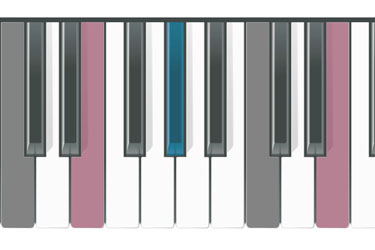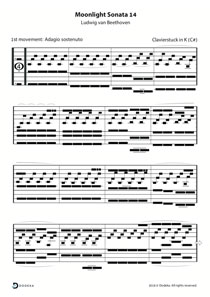How to Play Dodeka Sheet Music on Conventional Pianos
Posted on 12 October, 2018

- “Can I use the Dodeka sheet music with my conventional piano keyboard?”
We got this question a lot so we thought it would be a good idea to write an article about it.
So let’s go straight to the point. To the question “Can you use Dodeka sheet music with conventional pianos?”, the answer is yes.
Actually not only can you use it with conventional pianos, but the Dodeka notation also works with every instrument. Yes, you’ve heard it right, every instrument. And this includes the guitar you received for your 10th birthday, the saxophone that has been hanging around for years in your closet, or the out-of-tune upright piano in your living room.
How come you might be wondering?
Let's talk frankly. The magic behind Dodeka is found in the visual cues it creates between the notes on the score and the keys on the keyboard. Basically, it is all about the synergic relationship between the notation and the keyboard design. Not sure what we are talking about? Here's a quick reminder.
So, if we want to make conventional pianos or any other instrument compatible with Dodeka alternative music notation, we have to create the same visual cues. In other words, like the Dodeka keyboard, we want to highlight the four lines of the Dodeka stave on the piano keyboard or the instrument we want to play on.
And how do we do that?
For piano keyboards, we have come up with one quick and easy solution, that is, DIY stickers for keys. As the name suggests, it a series of stickers that you stick on your keyboard, more precisely on the keys C, E, P and C. This way, you will create the same visual cues as the ones you find on Dodeka keyboards and get a conventional piano dodeka-ready. Quite ingenious, right? :-)

An example of a conventional piano with the stickers stuck on the C, E P and C keys.
With this modded version of the keyboard, you can follow along Dodeka sheet music easily. When reading the scores, your job now is to see where the notes are positioned vis-à-vis the four lines, and use your stickers to find what key it matches. It's basically the same thing as what you would do on a real Dodeka keyboard.
No more key signatures to remember and flat or sharp to consider. Quite the dream, isn't it?
But before jumping for joy keep in mind that this quick hack is obviously not as good as a real Dodeka keyboard. Conventional keyboards weren’t designed for the Dodeka notation and vice-versa. The irregular layout of conventional pianos - the alternation between upper and lower keys - can sometimes make it difficult to recognise what lines or keys you are playing or should play. But apart from this small hiccup, stickers work fine and will certainly make you read and play your scores faster.
Do you remember the quick study we conducted at Lausanne art school? Participants who learnt a short song with Dodeka notation and its piano design were twice as fast as the ones who used conventional notation and the traditional piano layout. Why? Because they had the visual cues between the score and the keyboard. Nothing more really.
So now that you can also have these visual cues on your piano. imagine how you could improve your piano skills and how fast you could sight-read.
Want to try the stickers out? Reach out to us we have some that we are happy to give away. Or if you feel like it, here’s a template to print your own stickers at home.
(Think about the planet before printing your stickers. Make sure that they are the right size).
How useless would it be to put those stickers on your piano keyboard and have no sheet music to play? So here's a quick selection.
By the way, our sheet music library is almost done. So stay tuned because more scores will follow soon.
Enjoy and let us know what you think of this quick hack.
** We are currently working on the Dodeka Music Library project, which seeks to translate as many sheet music as possible into the Dodeka notation. Check out our progress and get early access to the first ever Dodeka music library. **


